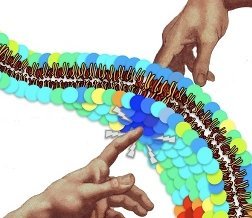
Cells live and function in a noisy world. In order to survive, they must engage in a dialogue with this environment. The transfer of information (and matter) from the outside to inside is regulated by the cell membrane. How the membrane achieves this control has been the subject of investigation for many decades now. A collaboration of scientists — cell biologists, physicists and chemists — has now identified a key physico-chemical process, and helped to deepen our understanding of how the cell membrane is organized.
The cell membrane is an asymmetric bilayer. This means that the inner and outer leaflets of the membrane are composed of different kinds of molecules. In order to allow specific information to be passed into the cell, “one can imagine the cell membrane as being composed of dynamic toll booths which regulate information between the inside and outside, and the way the toll booths are constructed are by bringing in specific molecules in space and time,” explained Madan Rao, a theoretical physicist from the Raman Research Institute (RRI) and NCBS.
When signaling receptors on the outside of the cell are activated, they modify the native membrane environment and create nanoclusters of molecules such as the glycosyl-phosphatidylinositol-anchored proteins (GPI-APs) that are tied to lipids on the cell surface. “The receptors are able to effect a certain dialogue with the membrane as they engage in signaling, and that has consequences for their output. So it is a sort of self-organizing system,” said Satyajit Mayor from National Centre of Biological Sciences (NCBS), Bangalore.
Previous work by Mayor and Rao’s teams showed that the formation of nanoclusters in the outer leaflet is driven by actin and myosin, which lie below the inner leaflet of the cell membrane. “The GPI proteins, which were our workhorse molecule to study local membrane composition, sit on the outer leaflet. They are somehow coupled to actin, across a scale of around 50 angstroms. So you need to have a way to transmit molecular information across this distance,” said Rao.
To understand the chemistry behind the construction of these little nanoclusters of lipid molecules in the outer leaflet, the researchers synthesized GPI analogues with different acyl chain lengths and saturation, working with Ram Viswakarma’s lab at the Institute for Integrative Medicine (IIIM), Jammu. They found that longer acyl chains facilitated nanocluster formation, suggesting that acyl chain interactions play an important role. “This gave us a clue that we should look for molecules in the inner leaflet that couple to actin on the inside and also have long acyl chains that can interact across the membrane,” said Anupama Ambika Anilkumar, one of the first authors of the study. They identified potential candidates and designed experiments to pinpoint the specific lipid, Phosphatidylserine (PS), which forms the vital link between actin and GPI.
Simultaneously, simulations from Rao’s lab were revealing similar results. “To model the coupling, we had to use molecular dynamics at the atomistic level. That is something I had never done before. I took it on at the behest of a very insistent student, Anirban Polley – who learnt the art of doing such simulations from